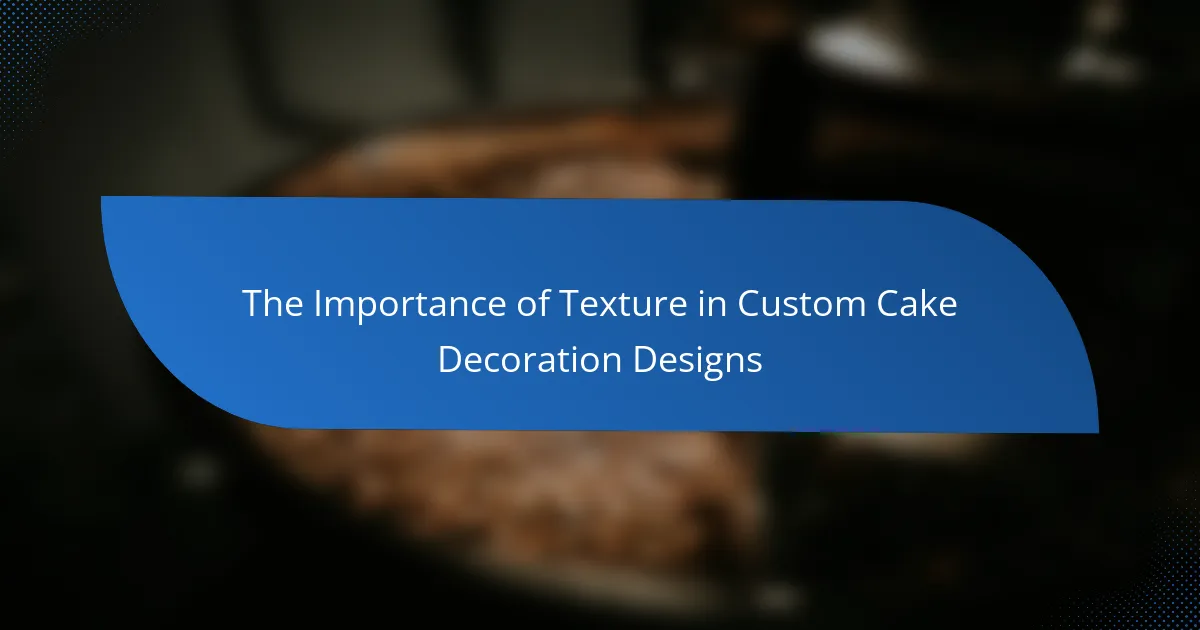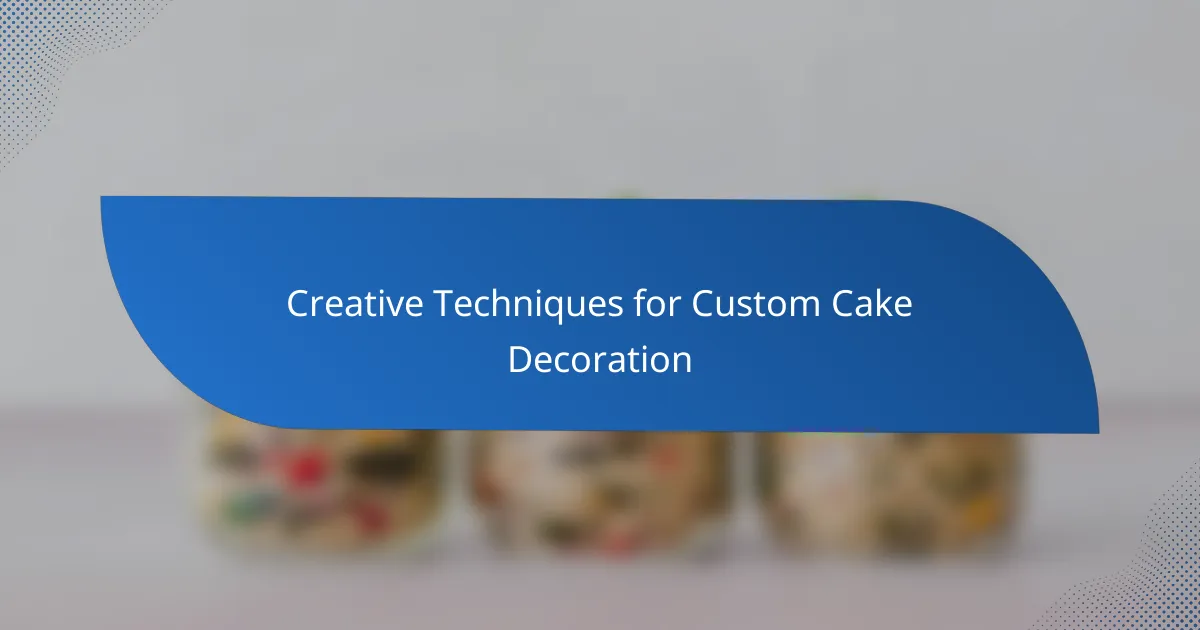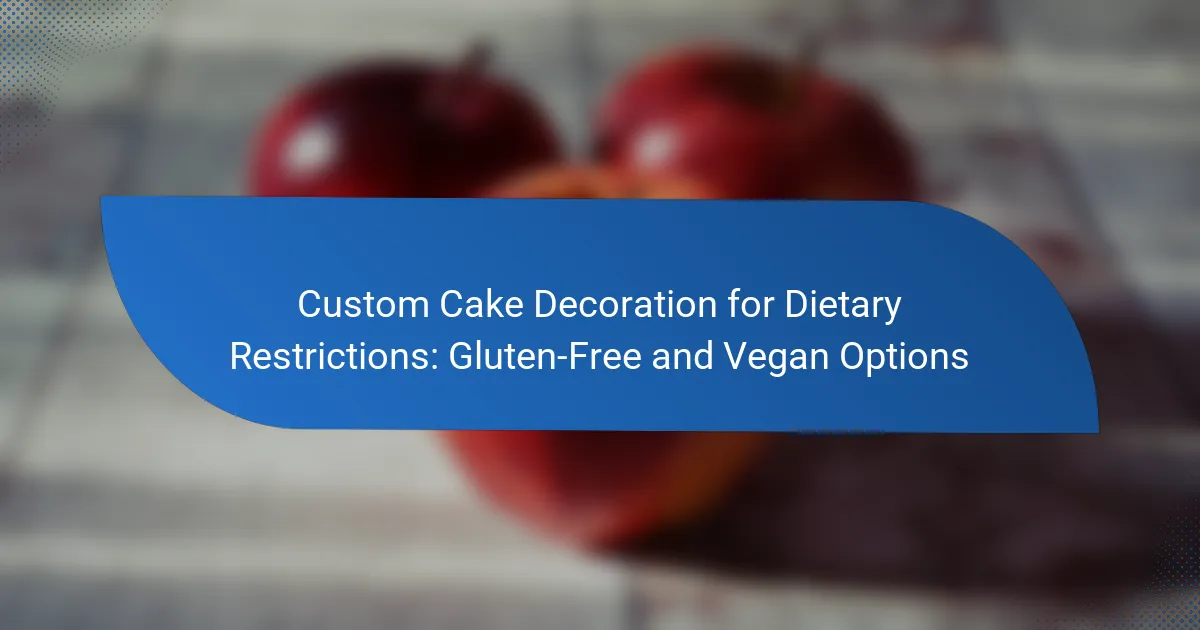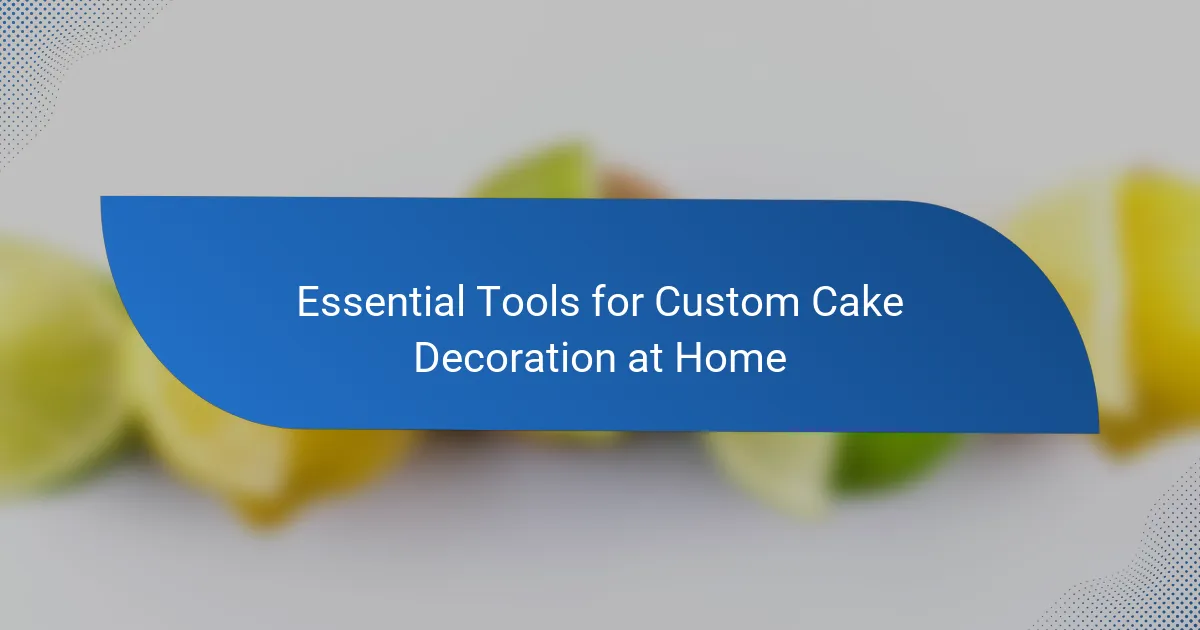Fondant is a smooth icing composed of sugar, water, and gelatin, widely used in custom cake decoration for its polished finish and versatility. This article explores various techniques involving fondant, including rolling, draping, and molding, which allow decorators to create intricate designs and detailed shapes. It also addresses common challenges faced when working with fondant, such as achieving the right consistency, temperature sensitivity, and the need for smooth finishes. By understanding these techniques and challenges, both professional and home bakers can enhance their cake decorating skills and achieve visually appealing results.
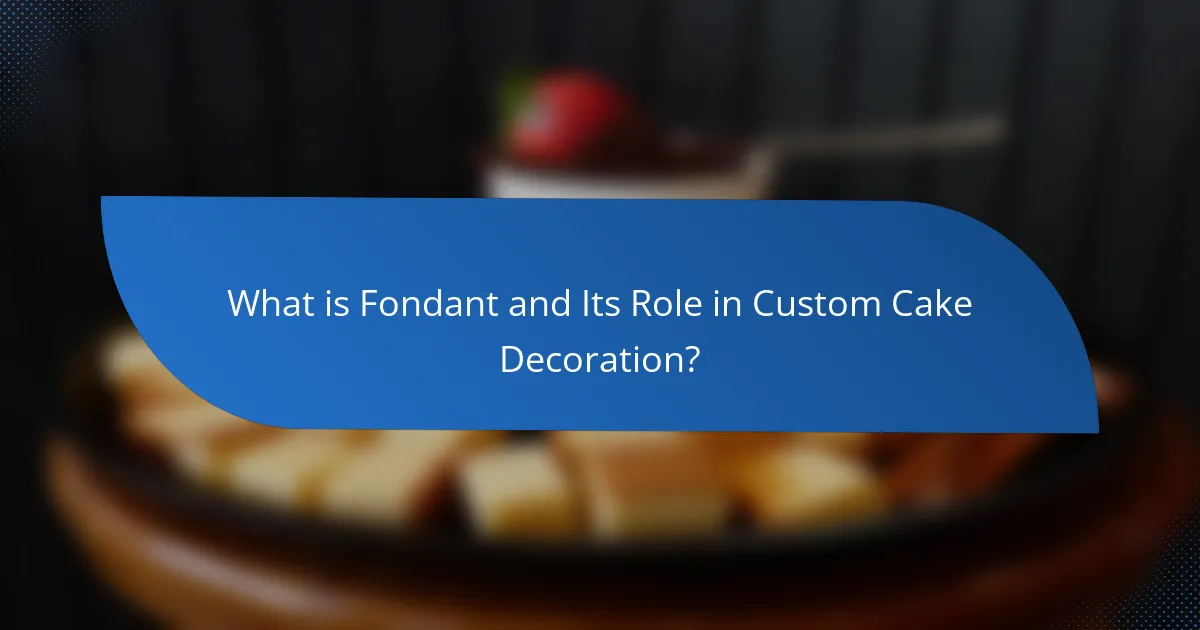
What is Fondant and Its Role in Custom Cake Decoration?
Fondant is a smooth icing made from sugar, water, and gelatin. It is used to cover cakes and create decorative elements. Fondant provides a polished finish that enhances the visual appeal of custom cakes. It can be rolled out and draped over cakes for a seamless look. Additionally, fondant can be molded into shapes for intricate decorations. Its versatility allows for various colors and designs. Fondant is preferred for its ability to hold detailed shapes and withstand humidity. This makes it ideal for elaborate cake designs and professional presentations.
How is Fondant Made and What Are Its Key Ingredients?
Fondant is made by combining sugar, water, and corn syrup. This mixture is heated until it reaches a specific temperature, typically around 240°F. Once heated, it is cooled slightly and then kneaded until smooth and pliable. Key ingredients include powdered sugar, glucose or corn syrup, and sometimes gelatin for added elasticity. These ingredients allow fondant to be rolled out and shaped easily for cake decoration. The smooth texture of fondant creates a polished finish on cakes. It can also be flavored or colored to enhance its aesthetic appeal.
What types of sugars are used in Fondant production?
Fondant production primarily uses granulated sugar and powdered sugar. Granulated sugar provides the base structure for fondant. It is typically boiled with water and corn syrup to create a syrup. This syrup is then combined with powdered sugar to achieve the desired consistency. Powdered sugar contributes to the smooth texture of fondant. It also helps in preventing the fondant from being too sticky. Some recipes may include glucose or corn syrup as additional sugars. These sugars enhance the flexibility and workability of the fondant.
How does the texture of Fondant impact its use in cake decoration?
The texture of fondant significantly impacts its use in cake decoration. A smooth and pliable texture allows for easy application and shaping. This texture enables decorators to create intricate designs and smooth finishes on cakes. Conversely, a dry or overly thick texture can hinder the ability to mold and adhere fondant properly. This can lead to cracks or uneven surfaces on the cake. Additionally, the texture affects how fondant interacts with other elements, such as buttercream or ganache. A well-textured fondant can seamlessly blend with these elements for a polished look. Ultimately, the right texture is crucial for achieving professional-quality cake decorations.
Why is Fondant Popular Among Cake Decorators?
Fondant is popular among cake decorators because it provides a smooth, polished finish. This icing can be rolled out and draped over cakes, creating a seamless appearance. It is versatile and can be molded into various shapes and decorations. Fondant also holds its shape well, making it ideal for intricate designs. Additionally, it can be easily colored and flavored to match themes. The ability to create 3D decorations and figures enhances its appeal. Many professional decorators prefer fondant for its aesthetic qualities and durability. These factors contribute to its widespread use in cake decoration.
What advantages does Fondant offer over other cake coverings?
Fondant offers several advantages over other cake coverings. It provides a smooth, polished surface that enhances the aesthetic appeal of cakes. Fondant is highly moldable, allowing for intricate designs and shapes. It can be rolled thin, creating a delicate finish that is difficult to achieve with buttercream. Additionally, fondant can be easily colored and flavored, offering versatility in decoration. It also helps to create a barrier that keeps the cake moist. This covering can be stored for longer periods without compromising quality. Overall, fondant’s properties make it a preferred choice for professional cake decorators.
How does Fondant enhance the visual appeal of custom cakes?
Fondant enhances the visual appeal of custom cakes by providing a smooth, polished finish. This icing can be molded into various shapes and designs. It allows for intricate detailing, such as flowers and patterns. Fondant can be colored easily, offering a wide range of hues. This versatility enables bakers to match themes and color schemes precisely. Additionally, fondant can create a uniform appearance, making cakes look professionally made. The smooth texture of fondant contrasts with other cake decorations, adding depth to the design. Overall, fondant transforms the aesthetic of custom cakes significantly.
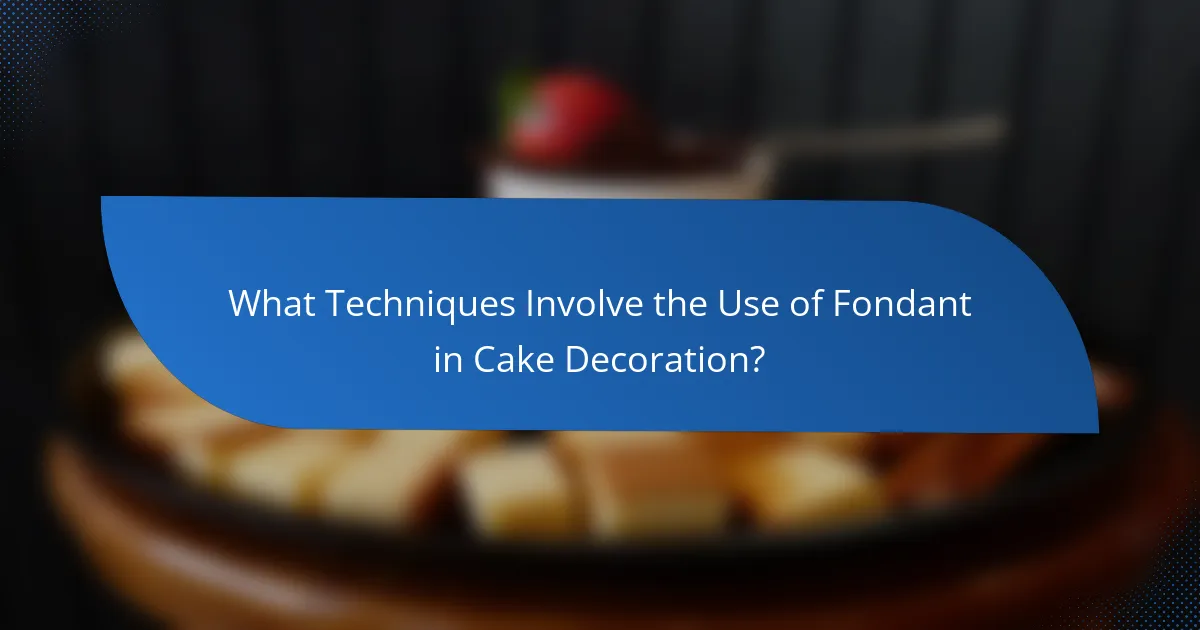
What Techniques Involve the Use of Fondant in Cake Decoration?
Techniques that involve the use of fondant in cake decoration include rolling, draping, and molding. Rolling fondant creates a smooth surface for cakes. Draping involves covering the cake with a sheet of fondant. Molding allows for the creation of decorative elements like flowers and figures. Other techniques include embossing, which adds texture, and painting, where colors are applied to enhance designs. These methods are widely used in professional and home baking. Each technique requires specific skills and tools for effective application.
How is Fondant Rolled and Shaped for Cake Decoration?
Fondant is rolled and shaped for cake decoration by first kneading it until smooth and pliable. This process ensures even consistency, making it easier to work with. Next, a clean surface is dusted with cornstarch or powdered sugar to prevent sticking. The fondant is then rolled out with a rolling pin to the desired thickness, typically about 1/8 inch.
Once rolled, the fondant is carefully lifted and draped over the cake. It is smoothed down using hands or a fondant smoother to eliminate air bubbles. Edges are trimmed for a clean finish. Fondant can also be shaped into decorative elements like flowers or figurines by using molds or hand-shaping techniques. These methods allow for intricate designs that enhance the overall appearance of the cake.
What tools are essential for rolling and shaping Fondant?
Essential tools for rolling and shaping fondant include a rolling pin, fondant smoother, and a sharp knife. A rolling pin helps achieve an even thickness for the fondant. The fondant smoother allows for a polished finish on cakes. A sharp knife is necessary for precise cutting and shaping. Additional tools may include fondant cutters and molds for decorative shapes. These tools are widely used by cake decorators to create professional-looking designs.
How do different thicknesses of Fondant affect cake design?
Different thicknesses of fondant significantly impact cake design. Thicker fondant can create a more structured and polished look. It allows for sharper edges and intricate details. However, it may also add weight to the cake. Thinner fondant provides a more delicate appearance. It can enhance the cake’s flavor profile by minimizing sweetness. The thickness also affects the fondant’s malleability and ease of application. For example, thicker fondant is less pliable and may crack during shaping. In contrast, thinner fondant can easily conform to the cake’s surface. This adaptability is crucial for achieving smooth finishes and complex designs.
What are Common Fondant Decoration Techniques?
Common fondant decoration techniques include rolling, draping, and molding. Rolling involves flattening fondant to cover cakes smoothly. Draping is the technique of applying rolled fondant over a cake, allowing it to fall naturally. Molding shapes fondant into figures or decorations, enhancing the cake’s design. Other techniques include cutting, where fondant is shaped with cutters, and painting, which adds color and detail. Texturing fondant creates patterns using tools or impressions. Each technique contributes to the overall aesthetic of the cake, showcasing the versatility of fondant in decoration.
How can Fondant be used for creating intricate designs?
Fondant can be used to create intricate designs by rolling it out into thin sheets. These sheets can be draped over cakes for a smooth finish. Fondant can also be molded into shapes like flowers and figures. The pliability of fondant allows for detailed decorations. Tools like cutters and embossers can enhance the designs further. Additionally, fondant can be painted or airbrushed for added effects. Edible glitter can be applied for sparkle and texture. This versatility makes fondant a favorite among cake decorators.
What methods can be employed for adding color and texture to Fondant?
To add color and texture to fondant, several methods can be employed. One common method is to use gel food coloring. This type of coloring allows for vibrant hues without altering the fondant’s consistency. Another method is to incorporate powdered food coloring, which can be kneaded into the fondant for a deep color. Airbrushing is also a popular technique, providing a smooth and even application of color.
For texture, fondant can be rolled with textured mats or embossed with stamps. This creates patterns and designs that enhance visual appeal. Additionally, using a paintbrush to apply edible luster dust can add shimmer and depth. These methods are widely used in cake decoration for achieving professional results.
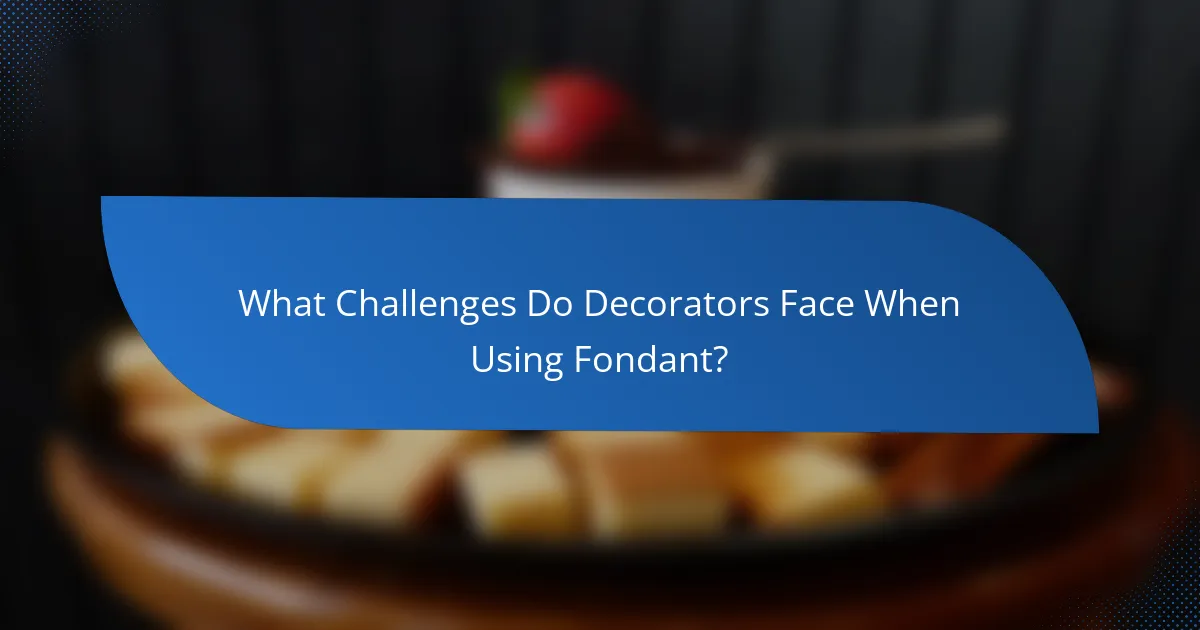
What Challenges Do Decorators Face When Using Fondant?
Decorators face several challenges when using fondant. One challenge is achieving the right consistency. Fondant can be too dry or too sticky, complicating application. Another challenge is temperature sensitivity. Fondant can melt or lose shape in warm conditions. Cracking is also a common issue. It can occur if fondant is rolled too thin or dried too quickly. Additionally, achieving smooth finishes can be difficult. Imperfections can show through fondant, requiring extra work to correct. Lastly, coloring fondant evenly can be tricky. Uneven coloring can lead to an unprofessional appearance. These challenges require skill and experience to overcome effectively.
How Can Humidity Affect Fondant Decorations?
Humidity can significantly affect fondant decorations. High humidity can cause fondant to become sticky and lose its shape. This can result in sagging or melting decorations. Fondant absorbs moisture from the air, which alters its texture. When fondant is too moist, it may not hold details well. Additionally, colors can bleed or fade due to excess moisture. Conversely, low humidity can make fondant dry out too quickly. This can lead to cracking or hardening of the decorations. Proper storage and environmental control are essential for maintaining fondant quality.
What techniques can mitigate the effects of humidity on Fondant?
To mitigate the effects of humidity on fondant, use cornstarch or powdered sugar for dusting surfaces. These substances absorb moisture and create a drier working environment. Additionally, consider using a dehumidifier in your workspace to lower humidity levels. This equipment effectively reduces moisture in the air, helping fondant maintain its integrity. Another technique is to store fondant in airtight containers to prevent moisture absorption. Keeping fondant wrapped tightly also preserves its texture and prevents stickiness. Lastly, avoid working with fondant in high humidity conditions, as this can lead to melting and deformation. Each of these techniques helps maintain fondant’s desired consistency and appearance.
What are the Best Practices for Storing and Handling Fondant?
Store fondant in a cool, dry place wrapped tightly in plastic wrap. This prevents it from drying out. Alternatively, place it in an airtight container. Do not refrigerate fondant, as moisture can cause it to become sticky. When handling fondant, ensure your hands are clean and dry. Use cornstarch or powdered sugar to dust surfaces and prevent sticking. Knead fondant before use to restore its pliability. For longer storage, freeze fondant wrapped in plastic and placed in a freezer bag. Thaw it at room temperature before use. These practices help maintain fondant’s texture and usability for cake decoration.
How can decorators prevent Fondant from drying out or cracking?
Decorators can prevent fondant from drying out or cracking by keeping it covered with plastic wrap when not in use. This helps retain moisture and prevents air exposure. Additionally, using a humid environment during the decorating process can be beneficial. Fondant should be kneaded with a small amount of shortening to keep it pliable. If fondant starts to dry out, decorators can apply a light mist of water or steam to restore moisture. Proper storage in an airtight container also helps maintain its freshness. These methods are effective as fondant is sensitive to air and humidity levels.
What Tips Can Help Beginners Master Fondant Cake Decoration?
To master fondant cake decoration, beginners should focus on a few key tips. First, ensure the cake is completely cooled before applying fondant. This prevents melting and maintains structure. Second, use a smooth layer of buttercream or ganache as a base. This helps the fondant adhere properly. Third, roll out fondant to an even thickness, ideally 1/8 inch. This allows for a smooth finish. Fourth, dust surfaces with cornstarch or powdered sugar to prevent sticking. This keeps the fondant workable. Fifth, practice shaping and smoothing techniques. This enhances the overall appearance of the cake. Lastly, learn to use tools like fondant smoothers and cutters. These tools help achieve professional-looking results.
What are essential tools for beginners working with Fondant?
Essential tools for beginners working with fondant include a rolling pin, fondant smoother, and sharp knife. A rolling pin helps to evenly flatten the fondant. A fondant smoother is used to create a sleek surface on cakes. A sharp knife allows for precise cutting and shaping of fondant pieces. Other useful tools are fondant cutters for shapes and molds for creating designs. A cornstarch pouch prevents sticking during work. Lastly, a silicone mat provides a non-stick surface for rolling out fondant. These tools are fundamental for effective fondant handling and decoration.
How can beginners practice Fondant techniques effectively?
Beginners can practice fondant techniques effectively by starting with basic shapes and gradually progressing to more complex designs. They should use high-quality fondant for better workability. It’s important to knead the fondant until it’s smooth and pliable. Beginners should also invest in essential tools like rolling pins, cutters, and smoothing tools. Working on a clean, non-stick surface helps prevent sticking. Watching tutorial videos can provide visual guidance on techniques. Practicing regularly builds muscle memory and confidence. Lastly, experimenting with different colors and textures enhances creativity and skill.
Fondant is a smooth icing made from sugar, water, and gelatin, widely used in custom cake decoration for its polished finish and versatility. The article explores the key ingredients and techniques involved in fondant production, including rolling, draping, and molding, as well as the impact of texture and thickness on cake design. It highlights the advantages of fondant over other cake coverings, such as its ability to hold intricate shapes and withstand humidity. Additionally, the article addresses common challenges decorators face, best practices for storage and handling, and essential tools for beginners to effectively master fondant techniques.
